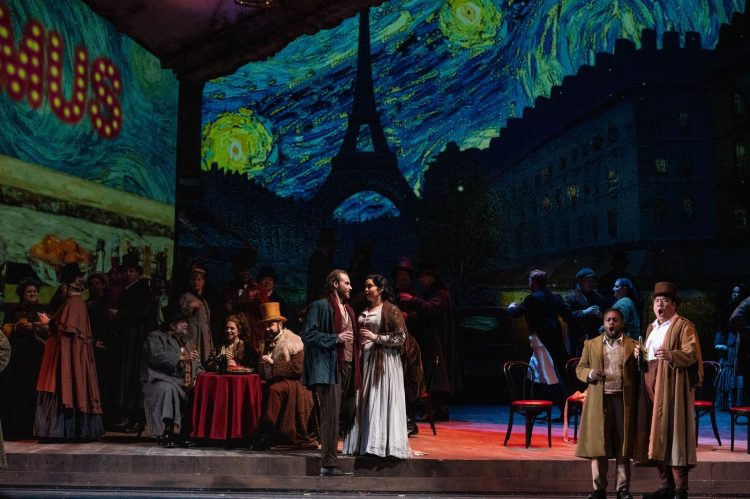
Opera Philadelphia in April 2019 revived one its most successful prior productions, a La Boheme with projected 19th-century art. Because I can not attend until the closing day, and to suggest what you will see, I submit my review from 2012:
It’s risky to get experimental with La Boheme. The opera, after all, is specific to a time and a place. What’s more, Puccini was precise and his music reflects the smallest details in the story: When a stove is lit, or a candle blows out, a cold wind blows, or someone tumbles down the stairs, the orchestra illustrates the action. So when a director tries to be too innovative he or she can negate Puccini’s intentions.
In the Opera Company of Philadelphia’s 2012 production director Davide Livermore kept the time and place where they should be and underlined this by using paintings from that period. The Philadelphia Museum of Art, Barnes Foundation and other museums licensed images of their art to the opera company.
The Bohemian roommates of La Boheme include an artist, of course, so it’s natural to see him painting and to see works by other artists that inspired him. Livermore’s choice of paintings was appropriate and the timing of their appearances was apt.
Renoir’s Woman Sewing appeared when Mimi described her job as a seamstress. Van Gogh’s Sunflowers dominated the walls as their romance bloomed, and Van Gogh’s Starry Night when evening came. When Rodolfo bought a bonnet for Mimi we saw Renoir’s Girl With Pink Bonnet.
In Act IV, Jean Beraud’s After the Misdeed showed a woman bent over, in a blue dress. Mimi arrived in that distressed posture, wearing a similar blue dress.
The painting Marcello was working on at the start of Act III was Monet’s Morning Haze, digitally enhanced to include branches that swayed back and forth. Through the windows of the Bohemians’s apartment you saw a cityscape by Pissaro, Morning Sunshine, and its clouds and chimney smoke moved. The production team animated the digital images in video-editing software and then created an HD movie of the animated images which was rear-projected onto the sets and sometimes beamed onto Marcello’s canvas.
The actions of the singers were somewhat busy but true to the story line. The horseplay among the men seemed right for a bunch of young guys on the Left Bank. Christmas Eve revelry at the Café Momus was intense, but appropriate, with street hawkers, stilt walkers, a fire breather, and the toy vendor Parpignol, while Musetta flirted with Marcello and her elderly date, Alcindoro, tried to satisfy her. To top it all off, a brass band marched across the stage.
I believe that Puccini would approve of this. No composer (save Meyerbeer) made such repeated use of theatrical spectacle. Witness his religious procession in Tosca, his horseback riding in Fanciulla del West and his Asian extravaganza in Turandot.
Some attendees may feel that this approach is too interventionist, but all of the colorful additions are apropos.
Norah Ansellem was an appealing Mimi. It would be good to have a Mimi whose voice embodied fragility, as Licia Albanese and Maria Callas did. Lacking that, Ansellem did a fine job of lightening her singing to indicate her character’s weakness. She radiated warmth when she entered Rodolfo’s cold apartment in the first act, and it was easy to see why he instantly fell for her.
Bryan Hymel was a Rodolfo with a voice that was ringing and sweet too. Troy Cook was the artist Marcello, in excellent voice and interacting nicely with the others. Leah Partridge was a Musetta who believably moved from superficiality to a loving caretaker for the dying Mimi.
Kevin Glavin excelled as Benoit the landlord in Act I and the bumbling Alcindoro in Act II. Jeremy Milner was the deep-voiced Colline and Craig Verm was the baritone Schaunard.
One unusual piece of business was intriguing. During the playful high-jinx of the roommates, when Schaunard impersonated a dancing woman, Colline gave him a quick kiss on the lips. After Mimi died, those two men hugged each other in consolation. It is not out of the question that Bohemians in Paris in the 1890s might, just possibly, be gay and be accepted.
Corrado Rovaris was the sensitive conductor.